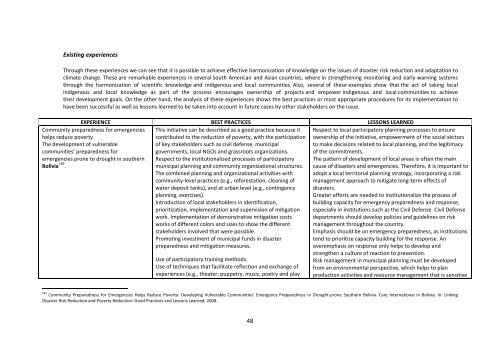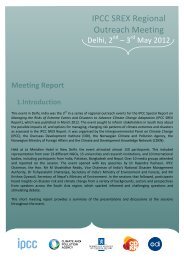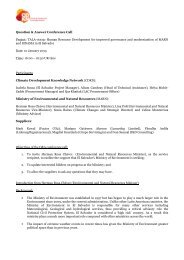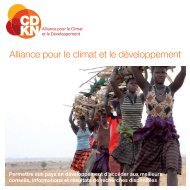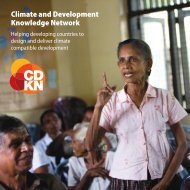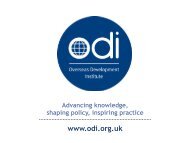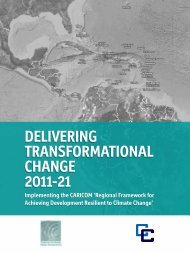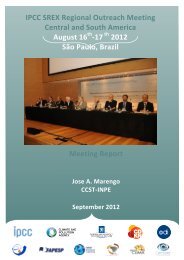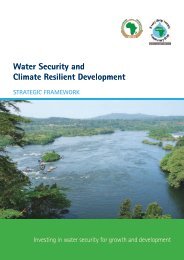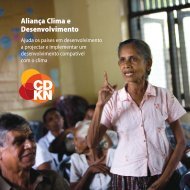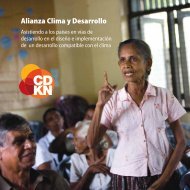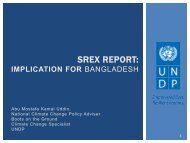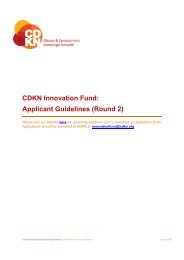Harmonized Perspectives - CDKN Global
Harmonized Perspectives - CDKN Global
Harmonized Perspectives - CDKN Global
- No tags were found...
You also want an ePaper? Increase the reach of your titles
YUMPU automatically turns print PDFs into web optimized ePapers that Google loves.
Existing experiencesThrough these experiences we can see that it is possible to achieve effective harmonization of knowledge on the issues of disaster risk reduction and adaptation toclimate change. These are remarkable experiences in several South American and Asian countries, where in strengthening monitoring and early warning systemsthrough the harmonization of scientific knowledge and indigenous and local communities. Also, several of these examples show that the act of taking localindigenous and local knowledge as part of the process encourages ownership of projects and empower indigenous and local communities to achievetheir development goals. On the other hand, the analysis of these experiences shows the best practices or most appropriate procedures for its implementation tohave been successful as well as lessons learned to be taken into account in future cases by other stakeholders on the issue.EXPERIENCE BEST PRACTICES LESSONS LEARNEDThis initiative can be described as a good practice because itcontributed to the reduction of poverty, with the participationof key stakeholders such as civil defense, municipalgovernments, local NGOs and grassroots organizations.Respect to the institutionalized processes of participatorymunicipal planning and community organizational structures.The combined planning and organizational activities withcommunity-level practices (e.g., reforestation, cleaning ofwater deposit tanks), and at urban level (e.g., contingencyplanning, exercises).Introduction of local stakeholders in identification,prioritization, implementation and supervision of mitigationwork. Implementation of demonstrative mitigation costsworks of different colors and sizes to show the differentstakeholders involved that were possible.Promoting investment of municipal funds in disasterpreparedness and mitigation measures.Community preparedness for emergencieshelps reduce povertyThe development of vulnerablecommunities’ preparedness foremergencies prone to drought in southernBolivia 183 .Use of participatory training methods.Use of techniques that facilitate reflection and exchange ofexperiences (e.g., theater, puppetry, music, poetry and playRespect to local participatory planning processes to ensureownership of the initiative, empowerment of the social sectorsto make decisions related to local planning, and the legitimacyof the commitments.The pattern of development of local areas is often the maincause of disasters and emergencies. Therefore, it is important toadopt a local territorial planning strategy, incorporating a riskmanagement approach to mitigate long-term effects ofdisasters.Greater efforts are needed to institutionalize the process ofbuilding capacity for emergency preparedness and response,especially in institutions such as the Civil Defense. Civil Defensedepartments should develop policies and guidelines on riskmanagement throughout the country.Emphasis should be on emergency preparedness, as institutionstend to prioritize capacity building for the response. Anoveremphasis on response only helps to develop andstrengthen a culture of reaction to prevention.Risk management in municipal planning must be developedfrom an environmental perspective, which helps to planproduction activities and resource management that is sensitive183 Community Preparedness for Emergencies Helps Reduce Poverty: Developing Vulnerable Communities’ Emergency Preparedness in Drought-prone Southern Bolivia. Care International in Bolivia. In: LinkingDisaster Risk Reduction and Poverty Reduction: Good Practices and Lessons Learned, 2008.48


